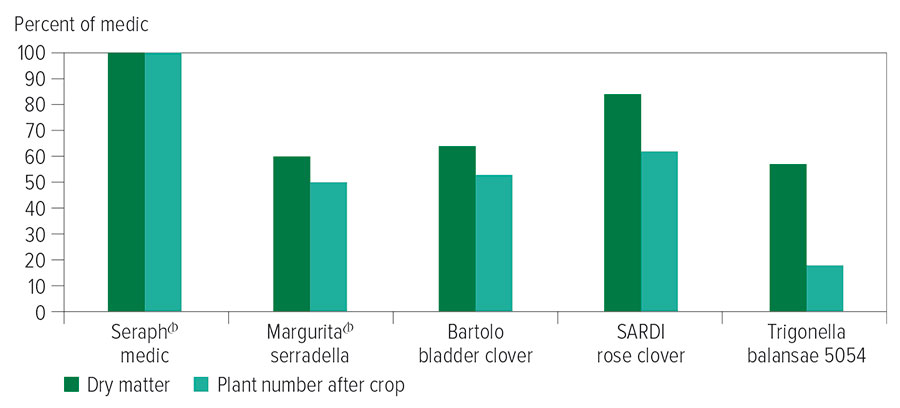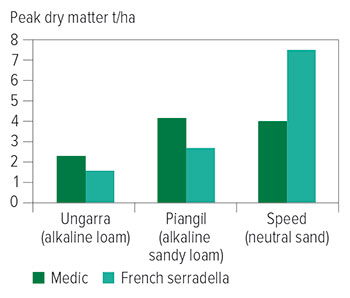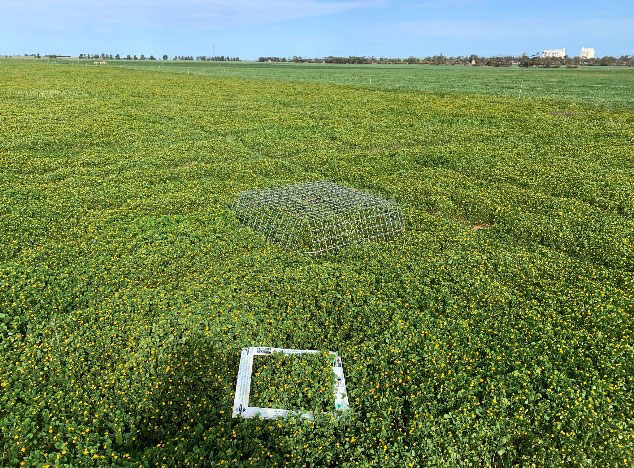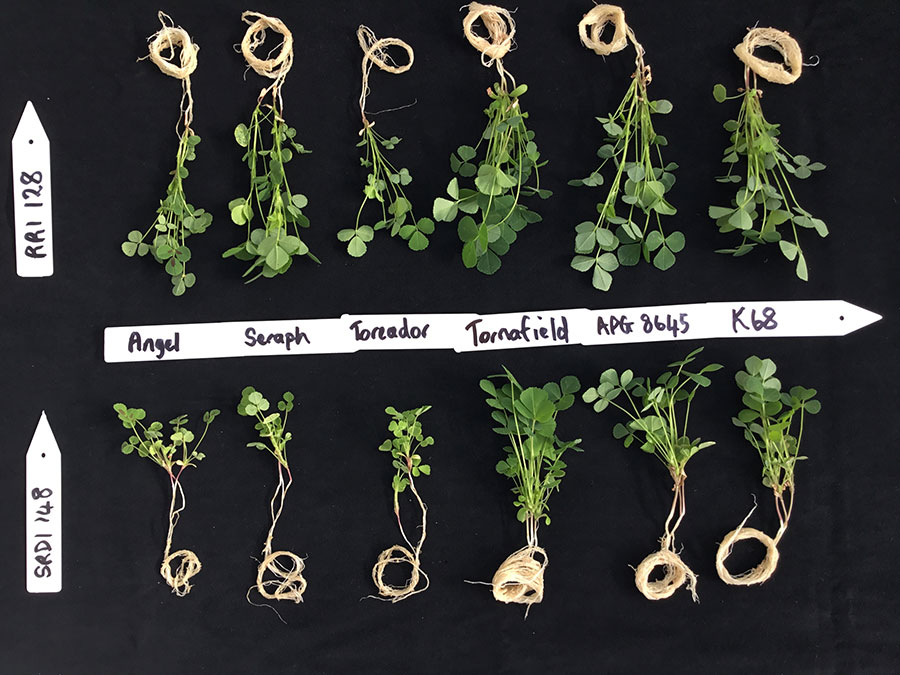Annual medics have a long history of performing well across millions of hectares of neutral to alkaline soils in the low to medium-rainfall areas of South Australia and Victoria, but the adoption of new varieties is sometimes limited by the cost and supply of seed.
In recent decades, several alternative ley pasture species have been developed that produce seed or pods that can be harvested with a grain harvester. Some also have an unusual seed softening process that makes them suitable for summer sowing in February or March.
Medic history
Annual medics (Medicago spp.) are well adapted to neutral to alkaline soils that are widespread in SA and Victoria.
The main medic species are barrel medics for loamy clays, strand medics for sandy loams and spineless burr medics for mildly acidic soils.
Medics have high levels of hard-seededness that allow them to regenerate after two to four crops, but they can also be grown in consecutive pasture years – which provides flexibility on mixed farms and benefits for following crops.
For example, at Lameroo in 2020, a single year of medic pasture increased yield of the following wheat by 1.8 tonnes per hectare, while two years of medic pasture increased wheat yield by 2.9t/ha.
As part of the national Dryland Legume Pasture Systems (DLPS) project, impressive crop benefits have been measured on soils where alternative legume species have grown well. These include French serradella (Ornithopus sativus), biserrula (Biserrula pelecinus), rose clover (Trifolium hirtum) and bladder clover (Trifolium spumosum).
But medics have been more consistent in their growth and especially in their regeneration after crops on neutral and alkaline soils (Figure 1).
Figure 1: Legume production in 2019 and plant number regenerating in 2021, after a cereal crop sown in 2020. Values expressed as a percentage of medic. Values are means from four sites.
 Source: SARDI
Source: SARDI
The success of the annual medics has been underpinned by many decades of breeding for a range of important traits. These include aphid resistance, tolerance of sulfonylurea herbicide and Intervix® herbicide residues, tolerance of high levels of soil boron, suitable hard-seeded levels and resistance to powdery mildew.
Medics also have many registered herbicide options and are well understood by growers.
A shortfall of medics is that they drop their pods at maturity, so seeds need to be harvested with a specialised vacuum harvester. This is where some alternative legume species have an advantage, as they hold their pods and can be harvested using conventional headers.
In WA and NSW, Margurita and Fran2o French serradellas and Bartolo bladder clover are suitable to summer sowing, where an increased rate of ‘hard’ seed or pod is sown in February.
Figure 2: French serradella outperformed medics on a neutral sand at Speed (Vic) but underperformed on alkaline sites at Ungarra (SA) and Piangil (Vic).

Source: SARDI
Key to the successful use of these species and summer sowing method is identifying the soil types where the alternative species perform well.
An example is provided in Figure 2, in which French serradella outperformed medic on neutral sand, whereas medic performed best on the two alkaline soils.
If interested in alternative species, we recommend initially sowing on small test areas.
Sowing up and down a slope in dune/swale paddocks will allow the alternative species to experience a range of soil textures and pH, indicating which part of the landscape they best perform.
While it is necessary to inoculate the seed of all legume species, the alternative species have specific rhizobia requirements and you need to ensure that a suitable inoculum is applied.
Efforts to improve the harvestabilty of annual medics were also instigated.
In preliminary work, with early desiccation of the medic sward, up to 900 kilograms of pods/ha was able to be harvested.
Further work is planned for harvesting and sowing of medic pods.
New variety development
The strand medic variety Seraph (Figure 3) was released in 2021 and has 15 per cent higher production than prior varieties.
It is resistant to powdery mildew and tolerant of sulfonylurea and Intervix ® herbicide residues.

Seraph strand medic growing at Minnipa, SA. Photo: Ross Ballard, SARDI
Along with other contemporary medic cultivars, it has hard-seeded levels that allow it to persist and regenerate after crop, and it is soft enough to allow consecutive pastures to be grown.
Two new spineless burr medic cohorts are being evaluated for potential release: one tolerant of soil boron, another tolerant to red-legged earth mites.
A lack of pasture options for deep alkaline sands has been identified by growers as a gap, with no disc medic varieties commercially available. A cohort of disc medics is being evaluated, focusing on the release of a variety with increased ability to form more-effective symbiotic relationships with rhizobia, fixing more nitrogen (Figure 4).

Figure 4: Variation in nitrogen fixation and growth of different medic varieties grown in hydroponics with the AL inoculant RRI-128 rhizobia (top) and a less effective strain (SRDI-148, bottom). The three disc medics on the right fix nitrogen well with both strains of rhizobia. Photo: Ross Ballard, SARDI
Trigonella balansae is a new species showing promise as an alternative to medic on alkaline soils. It is closely related to annual medic but is aerial seeded and can be harvested.
In historic work, the line APG5045 was identified as having the best agronomic performance, but its hard seed levels have proven too low for use as a ley legume pasture.
Lines with higher levels of hard-seed have been developed. By the end of autumn 2022, hard-seededness and regeneration studies will be completed to determine whether they are suitable as a variety. Release will also depend on a favourable outcome from animal studies being completed by CSIRO to ensure this new legume is suitable for grazing.
Arrowleaf clover (Trifolium vesiculosum) is another aerial-seeded species showing promise on alkaline soils. The DLPS project has selected an early flowering line for the low-rainfall zone, with a 30 per cent increase in dry matter compared to Cefalu arrowleaf clover. Further evaluation is needed to determine whether it is suited for release.
This research was part of the national Dryland Legume Pasture Systems project supported by the Australian Government Department of Agriculture, Water and Environment (DAWE) Rural R&D for Profit program and the Grains Research & Development Corporation, Meat & Livestock Australia and Australian Wool Innovation.
More information: Ross Ballard, 08 8 429 2217, ross.ballard@sa.gov.au
Read more: Resilient pastures for low rainfall mixed farms- crop and systems benefits provided by legumes.

























































